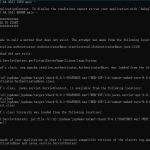本文来源于铁木箱子的博客http://www.mzone.cc
[本文地址] 本文永久地址是:http://www.mzone.cc/article/621.html
最近利用空闲时间研究了一把LDAP,然后用spring进行了一些编程尝试,通过spring的LdapTemplate可以很方便的进行LDAP的CRUD操作。如果你不清楚啥是LDAP的话,可以查询相关资料后再看此文。一般来说LDAP可以用来作为一个用户中心,围绕LDAP可以部署一些应用来共享相同的账号,这个在企业管理中是非常有帮助的,因为企业的内部应用可能是几个到几十个,员工如果有统一的账号密码,那将非常方便。
我也是因为内部需要,围绕LDAP做了一些应用集成,使用的LDAP服务器是apache的DS,标准的LDAP协议,客户端编程用java,使用spring的LdapTemplate类进行操作。使用maven管理的话,在项目中加入如下依赖:
<dependency>
<groupId>com.sun</groupId>
<artifactId>ldapbp</artifactId>
<version>1.0</version>
</dependency>
<dependency>
<groupId>org.springframework</groupId>
<artifactId>spring-ldap</artifactId>
<version>1.1.2</version>
</dependency>
然后就可以使用LDAP进行操作了,当然了也要加入其它的spring对应的包,比如core包等,下面分别说明使用spring的LdapTemplate如何进行操作。注意,在应用之前请先配置好apache-DS服务(请参考文章xxx)。
1、初始化LdapTemplate
private static final LdapTemplate template;
static {
LdapContextSource cs = new LdapContextSource();
cs.setCacheEnvironmentProperties(false);
cs.setUrl("ldap://192.168.1.188:10389");
cs.setBase("dc=mzone,dc=cc");
cs.setAuthenticationSource(new AuthenticationSource() {
@Override
public String getCredentials() {
return "mzonecc";
}
@Override
public String getPrincipal() {
return "uid=admin,ou=system";
}
});
template = new LdapTemplate(cs);
}
初始化时主要是设置连接地址、基础目录(我们这里是dc=mzone,dc=cc)和认证信息(包括账号和密码)。注意认证信息中getCredentials返回的是密码信息,而getPrincipal方法返回的是账号DN(基于基础目录)。
2、查询(搜索)
查询在LdapTemplate中是search说法,相关代码如下:
public User getUserById(String uid) {
String filter = "(&(objectclass=inetOrgPerson)(uid=" + uid + "))";
List<User> list = template.search("ou=rd", filter, new AttributesMapper() {
@Override
public Object mapFromAttributes(Attributes attributes) throws NamingException {
User user = new User();
Attribute a = attributes.get("cn");
if (a != null) user.setRealname((String)a.get());
a = attributes.get("uid");
if (a != null) user.setUsername((String)a.get());
return user;
}
});
if (list.isEmpty()) return null;
return list.get(0);
}
首先我们要构造一个filter,即search方法的第2个参数,这个filter是标准的LDAP查询过滤器,可以参考下LDAP的filter写法相关文档。
3、添加
public boolean addUser(User vo) {
try {
// 基类设置
BasicAttribute ocattr = new BasicAttribute("objectClass");
ocattr.add("top");
ocattr.add("person");
ocattr.add("uidObject");
ocattr.add("inetOrgPerson");
ocattr.add("organizationalPerson");
// 用户属性
Attributes attrs = new BasicAttributes();
attrs.put(ocattr);
attrs.put("cn", StringUtils.trimToEmpty(vo.getRealname()));
attrs.put("sn", StringUtils.trimToEmpty(vo.getUsername()));
attrs.put("displayName", StringUtils.trimToEmpty(vo.getRealname()));
attrs.put("mail", StringUtils.trimToEmpty(vo.getEmail()));
attrs.put("telephoneNumber", StringUtils.trimToEmpty(vo.getMobile()));
attrs.put("title", StringUtils.trimToEmpty(vo.getTitle()));
attrs.put("userPassword", StringUtils.trimToEmpty(vo.getPassword()));
template.bind("uid=" + vo.getUsername().trim(), null, attrs);
return true;
} catch (Exception ex) {
ex.printStackTrace();
return false;
}
}
在LDAP中是没有添加这一说法的,标准的叫法是绑定,对应的删除就是解绑。绑定时要将所有必须属性都添加上,首先是objectClass属性,这个是LDAP中的对象,LDAP中的对象是继承的,每个对象都有一些特定的属性,有些属性是必须的,有些是可选的。第2个步骤就是将每个对象的必须属性和你想要的非必须属性填上交由LdapTemplate进行绑定即可。
4、更新
public boolean updateUser(User vo) {
try {
template.modifyAttributes("uid=" + vo.getUsername().trim(), new ModificationItem[] {
new ModificationItem(DirContext.REPLACE_ATTRIBUTE, new BasicAttribute("cn", vo.getRealname().trim())),
new ModificationItem(DirContext.REPLACE_ATTRIBUTE, new BasicAttribute("displayName", vo.getRealname().trim())),
new ModificationItem(DirContext.REPLACE_ATTRIBUTE, new BasicAttribute("sn", vo.getUsername().trim())),
new ModificationItem(DirContext.REPLACE_ATTRIBUTE, new BasicAttribute("mail", vo.getEmail().trim())),
new ModificationItem(DirContext.REPLACE_ATTRIBUTE, new BasicAttribute("telephoneNumber", vo.getMobile().trim())),
new ModificationItem(DirContext.REPLACE_ATTRIBUTE, new BasicAttribute("title", vo.getTitle().trim()))
});
return true;
} catch (Exception ex) {
ex.printStackTrace();
return false;
}
}
更新就是替换属性,使用ModificationItem类进行处理。
5、删除
public boolean deleteUser(String username) {
try {
template.unbind("uid=" + username.trim());
return true;
} catch (Exception ex) {
ex.printStackTrace();
return false;
}
}
删除也就是解绑的过程,直接调用unbind即可。
上面几个操作基本上就覆盖了LDAP的基本操作,对于查询可能更多的是要注意如何些filter,增加要确定objectClass。另外,如果在初始化LdapContextSource时设置了base,那么后面的LdapTemplate中所有的操作DN都是基于改base构建而成的全路径,这个要注意。其他来说,看看代码就知道怎么回事了,相对比较简单。


